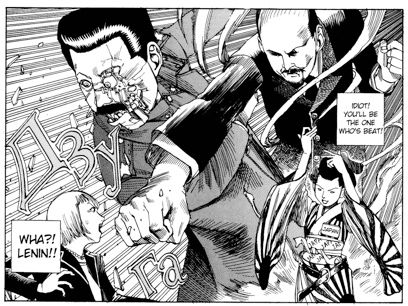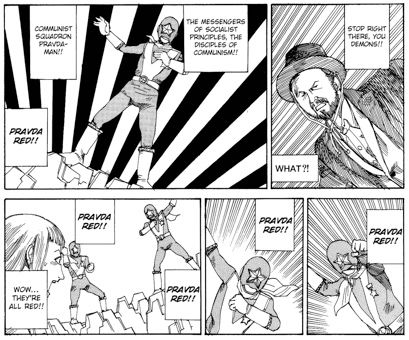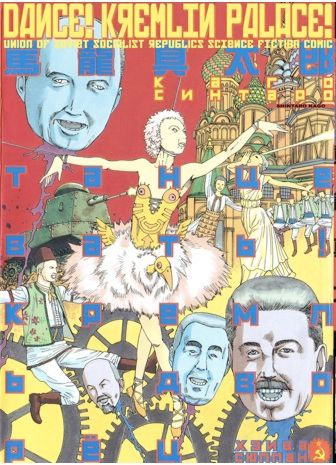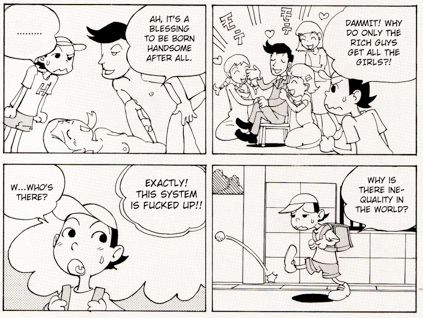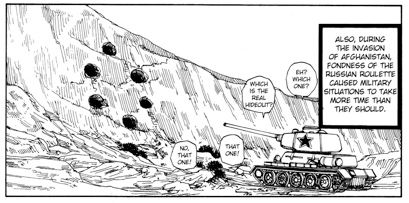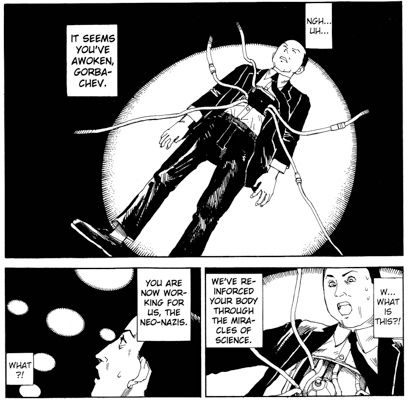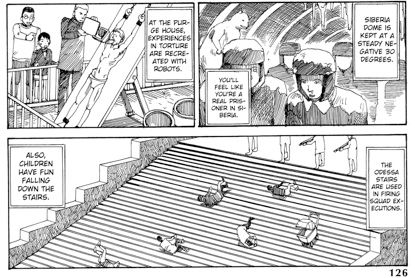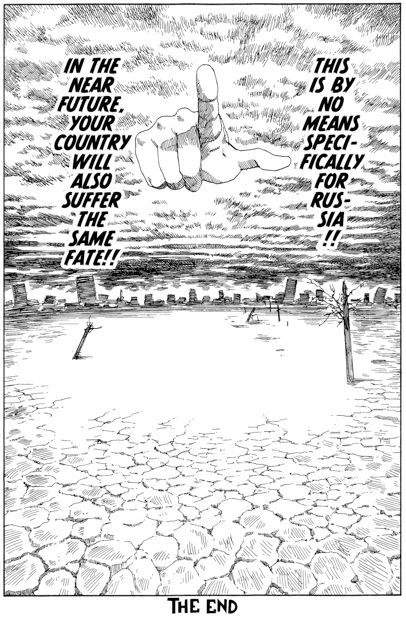I suppose this week's entry might be considered cheating a bit, since the work is easily available in English, albeit only online, in scantillation form. Still, while we may be heading towards a future where comics will be jacked into the backs of our spinal cords Existenz-style, with the individual panels displayed against the insides of our eyeballs, for the nonce this column will concern itself solely with comics that take up physical space, preferably printed on paper. And Dance! Kremlin Palace has, as far as I know, not yet fulfilled that requirement.
Before we begin I should probably offer a warning of sorts: many of the links and images and descriptions below probably don't fall under the NSFW banner, so if you're under 18, just pretend you never saw this post, OK? Oh, and remember: All comics are to be read right to left.
Dance! Kremlin Palace is the brainchild of one Shintaro Kago, whose name you may have seen around the Internet over the past few years, thanks largely to blogs like Same Hat! and Wanted: Cheap Manga, which trumpet his name loudly whenever possible.
Kago also has his own YouTube channel, which apparently has become rather popular. No doubt that's largely due to videos like this:
And, if that clip didn't make clear (and it probably didn't), Kago is usually filed under the category of "guro manga" artist. That's guro as in ero guro, which refers to a type of work that features a reliance on shocking, gruesome and often disturbing displays of sex, violence and general scatology. "Grotesque" is really the most apt synonym. Suehiro Maruo is probably the poster child of the movement, at least here in the West. "Fashionable paranoia" is another term that's used to describe Kago's work, which, while colorful, really only hints at the mania contained in his work.
For one thing, Kago is a bit of a formulist --- a lot of his shorter works like The Memories of Others and Abstraction frequently break the fourth wall or play with how comics manipulate space and time, though without ever once neglecting the artist's yen for drawing intestines and sexual organs.
The guro application also tends to overlook his skill as a satirist. In some ways he's akin to Michael Kupperman, in that both have healthy appreciations of the absurd -- particularly where pop culture is concerned -- though Kupperman shies away from the sort of NC-17 rated displays that Kago indulges in. Another more appropriate point of comparison may be Johnny Ryan, though Kago's more realistic art style makes the display of blood, guts, sex and scatology appreciably more unsettling than Ryan's comics ever do.
Only one of Kago's stories has seen print in the U.S. That would be "Punctures," which was included in Viz's Secret Comics Japan anthology. It's about a man whose anxiety causes him to make holes in everything he sees, because, after all, if there's already a hole in the milk carton, then he doesn't have to worry about it leaking. And, likewise, if his fellow worker takes his eye out, then he doesn't have to worry about being poked by an umbrella.
It's a formula Kago uses often -- taking realistic but illogical or obsessive behavior to absurd and somewhat frightening ends -- though Punctures is ultimately more of a conventional horror story as much as it is a satire on Japanese anxieties and social mores.
Dance! Kremlin Palace is probably closer in spirit and form to Punctures than his more experimental works, though it's as far from "conventional" as you can get without commenting on the medium. Ostensibly it's a satire of Communist Russia and Russian culture told through a series of interconnected short stories, though it doesn't really concern itself too much with "facts" or "history" beyond the few basic points most folks have absorbed through osmosis (vodka, caviar, purges). In other words, the comic is really about how we don't have a clue about what Russia (or by extension, any foreign culture) is really like.
It's also a pretty freaking weird book.
The first chapter, for example, is about a Russian Roulette tournament, because ... well, isn't that something Russians are into? I mean it's not called Samoan roulette after all.
Kago extends this notion to the near breaking point of absurdity, however, by suggesting that the game extends to all aspects of Russian life, where even the cannons have a one in six chance of firing.
Anyway, in the story a young girl is forced to try out for the tournament because she is apparently loaded to bear with good luck (she's had sex with several men and not gotten pregnant yet). Her training consists of knowing which buttons to push on the toilet and which door will not let her fall off of a cliff. Eventually she makes the finals, but not before using up all of her luck quotient. In a desperate move she tries to use up all her opponents luck as well (via attempted poisonings, etc.) but manages to lose anyway. The final panel shows her soul rocketing down to hell because, as noted, she already used up all her luck.
The book also skews our appreciation of famous world leaders as well. A chapter on Mikhail Gorabchev reveals he has a secret Glasnot power, which allows him to ferret out the truth of anyone. Affairs, perversions, nasty hobbies, it all is revealed whenever Gorby says his magic word. He's captured by a Neo-Nazis though, and turned into a cyborg for revenge purposes (the Nazis having lost the war and all). It's only when his lover plays The Internationale that he is able to override his programming. The Nazis respond by sending out cyborg versions of Breznyev, Krushchev and Yeltsin, but to no avail.
So yeah, strange comic. And I didn't mention diplomat who calls upon the ghost of Stalin to prevent Japan from gaining the upper hand in negotiations. Or the one where Stalin decides to help out a rundown village, notable mainly for the fact that all the farm equipment consists of naked women, in various states of dismemberment, debasement and highly sexualized contortions.
So yes, Kago is mocking the basic tenets of Communism and how they cannot be implemented in a human society. He's mocking how attempts implementation led to totalitarianism and the dehumanization and destruction of its citizens, most notably women (though I think Kago is trying to have a bit of his cake here and eat it too if you know what I mean).
Beyond that though, Dance! Kremlin Palace is a satire of general humanity's disregard for the complexities and intricacies of another seemingly alien culture and the seemingly basic need to strip a society down to an almost cartoon-like essence.
It's also very funny. I don't think I've really conveyed just how comical and laugh-out loud this book is. Kago has a really affinity for the deadpan gag (another talent he shares with Kupperman) and he utilizes it here to the utmost, conveying the most bizarre behavior with no more than a shrug. The horror of some images only serves to underscore the absurdity of the various stories.
Kago might be a bit of a hard sell. He's too violent and explicit for one of the big mainstream publishers like Viz to take on, and his art style may be too representational for the avant-garde crew. That being said, he's an artist worthy of attention and it's about time more Westerners (the ones that have strong stomachs) were made aware of his work.
Really, I'd be happy to see just about any of Kago's manga collected in print, but Dance! Kremlin Palace seems like as good a place to start as any.

